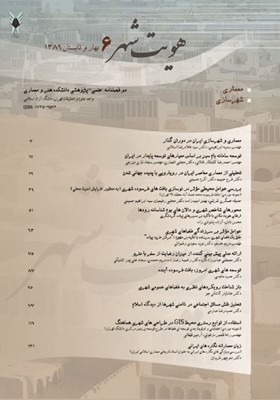استفاده از توابع رستری محیط GIS در طراحی شهری هماهنگ
محورهای موضوعی : معماریراما قلمبر دزفولی 1 , آرمین قهقائی 2
1 - دانشجوی دکترای تخصصی شهرسازی ، دانشگاه آزاد اسلامی، واحد علوم و تحقیقات تهران، ایران. (مسئول مکاتبات)
2 - کارشناس ارشد سنجش از دور و سیستم اطلاعات جغرافیایی، دانشگاه تربیت مدرس
کلید واژه: GIS, Urban design, همپوشانی, طراحی شهری هماهنگ, تحلیل رستری, درونیابی فضایی, فیلترگذاری, Raster models, weighted Overlay functions,
چکیده مقاله :
یکی از زیر شاخه های شهرسازی که شاید محدودتر با GIS در ارتباط بوده، طراحی شهری است. آن چه در مقالات کاربرد GIS در طراحی شهری مشاهده میشود اکثرا مربوط به توان نمایش سه بعدی نرم افزارهایGIS است. حال آنکه یکی از بهترین امکانات سامانه اطلاعات مکانی توان بالای تحلیلی و جستجوی مکانی و توصیفی با کمک پایگاه داده متصل به سیستم است. هدف از این مقاله بررسی قابلیتهای تحلیلی GIS برای پروژههای طراحی شهری بوده و پیامد تجربه ای است در یک نمونه موردی پروژه طراحی شهری که توانست تا حدود زیادی توافقی عمومی بین گروههای ذینفع را ایجاد نماید. این تجربه نشان داد که بسیاری از فرآیندهای ذهنی طراح را میتوان بهطور جامع و همه جانبه با نگاه فازی، و با کمک فضای انعطافپذیر محیط رستر و توابع مربوطه مدلسازی نمود. لذا تجربه مذکور میتواند باب جدیدی را برای استفاده از GIS در پروژههای طراحی شهری باز نماید.
After victory of Islamic Revolution in 1360 (1981), wide mutations as a result of excited values of the Revolution caused lots of changes in different fields, including architecture. Following this, Cultural Revolution designers were adapted with new requirements of the community and orientations that introduced Revolution’s mottos after relative establishment of structure and educational contents of the universities. This matter, in conformity with general spirit of personality seeking processes of architecture, introduced necessity of changing in architecture training programs. In the field of architecture training, self-reversion , revival of past stable values, Permanent concepts are in history, structure and content of training program from the viewpoint of Cultural Revolution designers about importance of theoretical studies in training, joining of architecture training with precinct culture, historical examination of architecture before modernism, of national and zone perspective. Existence of word identity in the introduction of Cultural Revolution staff program in 1363 (1984), demonstrated attentions towards basics of new training program of architecture. Then, seeking identity in training process is followed by emphasizing on Islamic architectural history and Iranian architectural history. This period was contemporary with predominance of global process of postmodernism on West architecture. Postmodernism thoughts, criticizing inattention of modern architecture thinkers towards history of establishment of architecture in different places, chooses increasing, antonym, complex and metaphorical in its expressions. Prevalence of West postmodernism numerosity thoughts resulted in establishment of most of Iranian contemporary architecture works. On one hand, contemporary human’s social life, expansion of relationships and breaking boundaries are mixed with globalization idea. Contemporary world’s occurrences and mutations have widespread concepts in today life. Community technology, telecommunication, internet, satellite and so are things that involve human in network of relationships in different manners. So, after technical and technological advances of modernism, media could broadcast art and architecture mutations all around the world as other matters. Postmodernism attitude could increase its symbolic dimensions and attendance ways. Iran’s temporary architecture, which has a root in past architecture, is together with global widespread mutations, as a result of today world’s achievements and ideal that belongs to all of humans. Today architectures encounter with twosome status of doubt towards past values and captivation towards new values, as well as sentiment coherency to the past and excitement to the future; and this matter force them to search about recognition of personal and collective identity. Despite entering of current thoughts in West architecture to Iran, before entering and usage, tools and information technology was growing slowly and after the movement, it grows fast. It is necessary to evaluate reasons and results of these changes. While theoretical basics resulted from consideration of personality seeking, on one hand, and entrance of attitudes in West architecture on the other hand, (but without passing prerequisite processes that was caused appearance of the aforesaid thoughts), have significant influence on architecture of Iran. The present study involved in explaining Iran’s architecture approach after the Revolution and evaluating its personality seeking objectives against a phenomenon, called globalization, emersion of information technology, media and computers.
_||_

